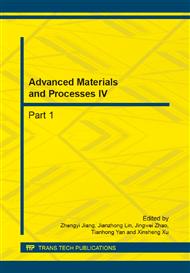p.3
p.7
p.11
p.15
p.21
p.25
p.30
p.34
Cu–Ni Alloy Nanoparticles Supported on Multiwalled Carbon Nanotubes Composites with Pre-Treated Multiwalled Carbon
Abstract:
Carbon nanotubes (CNTs) have aroused widespread concern for their unique structure and excellent properties in physical, chemical and mechanical. Fileds copper-nickel alloy (Cu-Ni) is a kind of important conductive metal materials that can be widely used in electric, magnetic, catalytic and many other fields as well. The combination of nanocomposites exhibit excellent comprehensive properties which it make it one of the most promising areas at present. This paper shows the preparation of the work and the test result of carbon nanotubes (CNTs) load the nanocopper-nickel alloy (Cu-Ni/CNTs) composite materials that the nanocomposite can be used as an electrode material and fuel cell. In this paper, carbon nanotubes (CNTs) which were acidized by mixed acid are used as templates to prepare nanocopper-nickel alloy (Cu-Ni/CNTs) composite materials. Experiments prove their electrochemical activity is superior to the pure alloy in alkaline solution, and the peak reaches maximum value when alloy is 20 wt%.
Info:
Periodical:
Pages:
7-10
Citation:
Online since:
September 2014
Authors:
Price:
Сopyright:
© 2014 Trans Tech Publications Ltd. All Rights Reserved
Share:
Citation:


